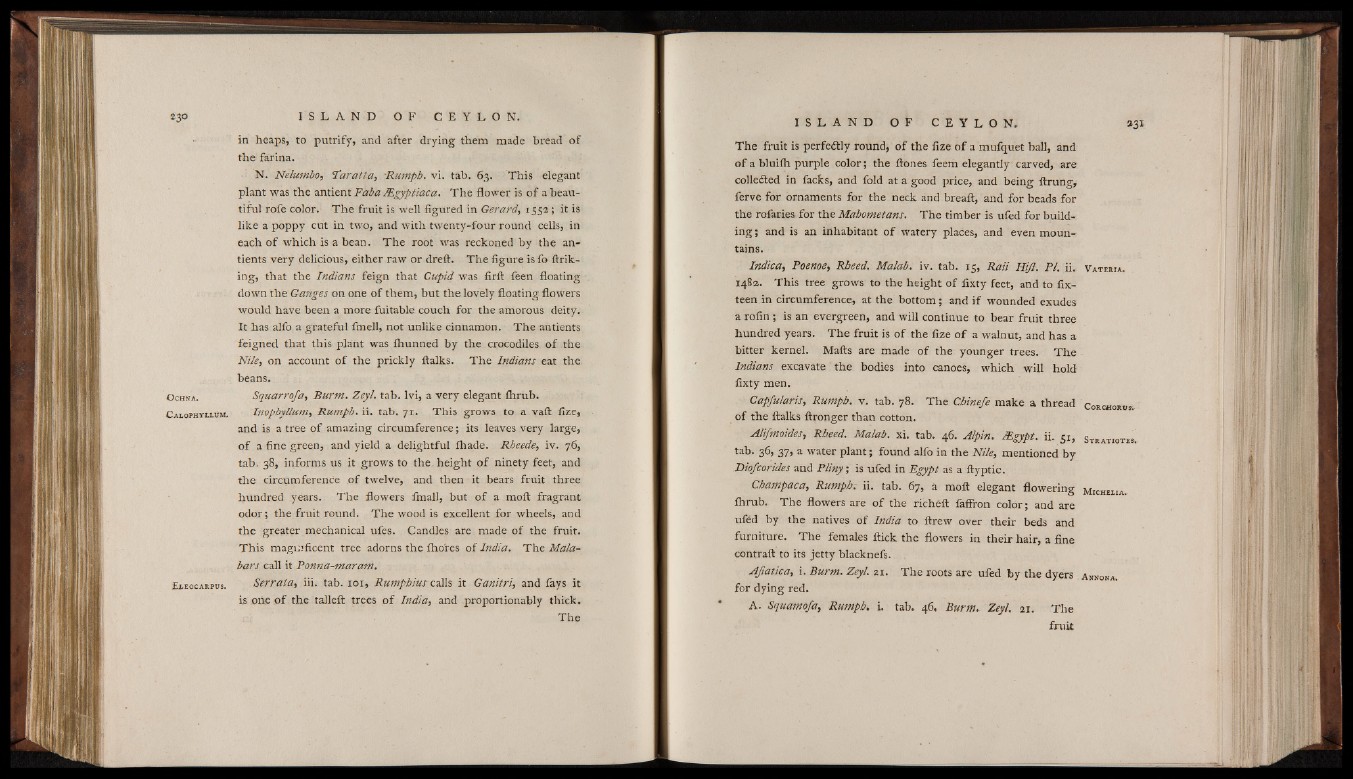
O CH N A .
C alophyllüm.
£ j. e o c a r p u s .
in heaps, to putrify, and after drying them made bread of
the farina.
N. Nelutnbo, Taratta, Rumph. vi. tab. 63. This elegant
plant was the antient Faba JEgyptiaca. The flower is o f a beautiful
rofe color. The fruit is well figured in Gerard, 1552; it is
like a poppy cut in two, and with twenty-four round cells, in
each of which is a bean. The root was reckoned by the an-
tients very delicious, either raw or dreft. The figure is fo linking,
that the Indians feign that Cupid was firit feen floating
down the Ganges on one of them, but the lovely floating flowers
would have been a more fuitable couch for the amorous deity.
It has alfo a grateful fmell, not unlike cinnamon. The antients
feigned that this plant was Ihunned by the crocodiles of the
Nile, on account of the prickly italks. The Indians eat the
beans.
Squarrofa, Burnt. Zeyl. tab. lvi, a very elegant Ihrub.
Inophyllum, Rumpb. ii. tab. 71. This grows to a vail fize,
and is a tree o f amazing circumference; its leaves very large,
o f a fine green, and yield a delightful ihade. Rheede, iv. 76,
tab. 38, informs us it grows to the height o f ninety feet, and
the circumference o f twelve, and then it bears fruit three
hundred years. The flowers fmall, but of a molt fragrant
odor; the fruit round. The wood is excellent for wheels, and
the greater mechanical ufes. Candles are made of the fruit.
This magnificent tree adorns the Iho'res of India. The Mala-
bars call it Ponna-maram.
Serrata, iii. tab. 101, Rumpbius calls it Ganitri, and lays it
is one o f the talleil trees of India, and proportionably thick.
The
The fruit is perfedtly round, o f the fize o f a mufquet ball, and
o f a bluiih purple color; the itones feem elegantly' carved, are
colle£ted in facts, and fold at a good price, and being ftrung,
ferve for ornaments for the neck and breaft, and for beads for
the rofaries for the Mahometans. The timber is ufed for building
5 and is an inhabitant o f watery places, and even mountains.
Indica, Poenoe, Rbeed. Malab. iv. tab. 13, Raü Hiß. PI. ii.
1482. This tree grows to the height of fixty feet, and to fix-
teen in circumference, at the bottom; and i f wounded exudes
a rofin ; is an evergreen, and will continue to bear fruit three
hundred years. The fruit is o f the fize o f a walnut, and has a
bitter kernel. Mails are made o f the younger trees. The
Indians excavate the bodies into canoes, which will hold
fixty men.
Capfularis, Rumph. v. tab. 78. The Chinefe make a thread
o f the ilalks ftronger than cotton.
Alifmoides, Rheed. Malab. xi. tab. 46. Alpin. ¿Egypt, ii. 51,
tab. 36, 37, a water plant; found alfo in the Nile, mentioned by
DioJ.'corides and Pliny; is ufed in Egypt as a ftyptic.
Champaca, Rumpb: ii. tab. 67, a moil elegant flowering
Ihrub. The flowers are o f the richeft faffron color; and are
ufed by the natives o f India to llrew over their beds and
furniture. The females flick the flowers in their hair, a fine
contrail to its jetty blacknefs.
Afiatica, i. Burm. Zeyl. 21. The roots are ufed by the dyers
for dying red.
A. Squamofa, Rumph. i. tab. 46, Burm. Zeyl. 21. The
fruit
V a t e r ia .
C or chorus.-
St r a t io t e s .-
M ichelia.
A nnona.